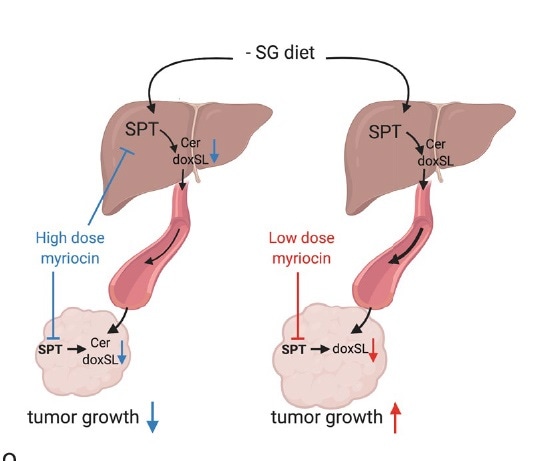According to a new study performed by researchers from the University of California, San Diego, the enzyme called serine palmitoyl-transferase can be utilized as a metabolically responsive “switch” that reduces the growth of tumor.

Schematic describing in vivo sphingolipid physiology under high- and low-dose myriocin treatments. Image Credit: University of California San Diego.
The study results were published in the Nature journal on August 12th, 2020.
The researchers induced tumor cells to synthesize a toxic lipid by pharmacologically targeting the phosphoglycerate dehydrogenase—a serine synthesis enzyme—or limiting the dietary amino acids called glycine or serine. This toxic lipid slows the progression of cancer in mice. But more studies are required to establish how this method could be translated to patients.
In the past 10 years, scientists have come to know that eliminating the glycine and serine amino acids from animal diets slows down the development of certain tumors. But a majority of researchers have focused on the effect of these diets on antioxidant activity, DNA metabolism, and epigenetics.
On the other hand, the team from the University of California San Diego and the Salk Institute for Biological Studies observed a major effect of these interventions on tumor lipids, specifically those found on the cell surface.
Our work highlights the beautiful complexity of metabolism as well as the importance of understanding physiology across diverse biochemical pathways when considering such metabolic therapies.”
Christian Metallo, Study Corresponding Author and Professor, Department of Bioengineering, Jacobs School of Engineering, University of California San Diego
In this example, the researchers focused on serine metabolism. The enzyme serine palmitoyl-transferase, also called SPT, usually makes use of serine to produce fatty molecules known as sphingolipids, which are crucial for the functioning of cells. However, if there are low serine levels, the enzyme can behave “promiscuously” and employ a different type of amino acid, like alanine, which leads to the production of noxious deoxysphingolipids.
The researchers decided on this research direction after investigating the affinity of specific enzymes toward serine and comparing these enzymes to the concentration of serine in tumors. Such levels are called the Michaelis constant or Km and the numbers pointed to sphingolipids and SPT.
By linking serine restriction to sphingolipid metabolism, this finding may enable clinical scientists to better identify which patients’ tumors are most sensitive to serine-targeting therapies.”
Christian Metallo, Study Corresponding Author and Professor, Department of Bioengineering, Jacobs School of Engineering, University of California San Diego
Such toxic deoxysphingolipids are extremely powerful at reducing the cell growth in “anchorage-independent” conditions—a condition in which cells cannot easily attach to surfaces that better imitate the growth of tumor in the body.
More research is required to have a better understanding of the mechanisms by which deoxysphingolipids are harmful to cancer cells and the kind of impacts they have on the nervous system.
In the study, published in the Nature journal, the researchers fed a low-glycine and serine diet to xenograft model mice. They noticed that SPT turned to alanine to create toxic deoxysphingolipids rather than normal sphingolipids.
The team also used the amino-acid based antibiotic myriocin to block the synthesis of SPT and deoxysphingolipids in mice fed with low-serine and glycine diets and observed that tumor growth was enhanced.
If an organism is deprived of serine for long time, it causes eye disease and neuropathy, pointed out Metallo. In 2019, Metallo co-headed an international group that successfully identified that accumulation of deoxysphingolipids and reduced serine levels are a major driver of macular telangiectasia type 2, or MacTel—a rare macular disease.
The study was published in the New England Journal of Medicine. But restriction of serine or drug treatments for tumor therapy would not need the extended treatments that lead to age-related diseases or induce neuropathy in animals.
Source:
Journal reference:
Muthusamy, T., et al. (2020) Serine restriction alters sphingolipid diversity to constrain tumour growth. Nature. doi.org/10.1038/s41586-020-2609-x.